 |
 |





 |
 |
 |
 |
 |
 |
New, responsive Twin Cities ramp metering system starts in March 2002
|
 |
 |
 |
Mn/DOT announced start
of the new ramp meter timing system at a Nov. 27 news conference. From
left are Marc Cutler, Cambridge Systematics; Dick Stehr, Metro Division
engineer; and Commissioner Elwyn Tinklenberg. Photo by Craig Wilkins
|
Twin Cities drivers will experience more reliable travel times with the installation
of a new ramp meter timing system that will limit individual wait times to no
longer than four minutes. Mn/DOT will launch the new system in March 2002 on
approximately 30 percent of Twin
Cities metro area ramp meters; full implementation will be completed by
the end of 2002.
Mn/DOT announced the start of the new system at a Nov. 27 news conference.
The department will begin testing new software for the system in January.
Responding to questions at the news conference about ramp meter operations,
the commissioner said the meters are only one tool used to manage growing traffic
congestion in the Twin Cities metro area.
"We need more capacity. The real issue is for the legislature to fund
long-term, multi-modal congestion relief statewide," said Commissioner
Elwyn Tinklenberg. "It’s time to get on with that agenda."
The new responsive system follows a year-long study and extensive public opinion
research after the legislature directed a ramp meter shutdown last fall. When
the ramp meter shutdown study ended Dec. 8, 2000, several interim changes to
the ramp metering system occurred: a number of meters were left off; ramp meter
operations were limited to four hours each day; and faster metering rates were
used.
"We’ve conducted a comprehensive study since the shutdown, which included
commuter polling feedback, and now we want to apply what we’ve learned to the
ramp meter system," Tinklenberg said. "The public told us what it
wants, and we have addressed those concerns. We think this new system will provide
us with a tool to help manage congestion without long waits at ramp meters."
According to Tinklenberg, the goals of the new ramp metering system are to:
-
Reduce delays caused by congestion and crashes
-
Reduce the number of crashes caused by congestion
-
Provide travelers with more reliable travel times
-
Manage ramp meter wait times
A key aspect of the new responsive ramp metering system is the addition of
an automated system that will monitor wait times at meters so they can be adjusted
as needed by Mn/DOT’s Traffic Management Center computers. The new system will
provide real time information about ramp delays and will limit wait times based
on ramp conditions as well as freeway conditions.
Specific system features:
-
Ramp meter waits will be no more than four minutes on local ramps and no
more than two minutes on freeway-to-freeway ramps.
-
Vehicles waiting at meters will not back up onto adjacent roadways.
-
Meter operation will respond to congestion and only operate when needed.
In addition, 24
current ramp meters will be removed in 2002. These meters are not currently
being used and, based upon traffic projections, will not be needed in those
areas for at least five years.
The new timing system is based on recent market research and traffic data analysis
conducted by Cambridge Systematics. Marc Cutler, Cambridge vice president, said
an examination of the current operating system found that it is ineffective.
"We found that traffic operations and safety continued to experience the
degraded performance which was documented during the shutdown," he said.
Results of the Cambridge Systematics work show that:
-
Crash rates increased by 15 percent when comparing the first seven months
of years 1998-2000 (fully metered) and year 2001 (interim metering operation)
-
Freeway speeds in 2001 varied from corridor to corridor, but were consistently
5-10 percent slower than in 2000
-
Freeway travel times also varied from corridor to corridor, with results
showing them to be consistently 5-10 percent longer in 2001 than in 2000
"New market research by Cambridge Systematics shows strong support for
modification of the system," added Cutler.
A major market research finding shows that 60 percent of commuters polled support
modification of the ramp metering system. About one-quarter believe that the
system should continue to operate as is while 14 percent believe that the meters
should be shut down completely.
"These percentages are similar to those expressed during the pre-shutdown
condition, except support for a complete shutdown has declined significantly
from 21 percent previously," he said.
Check Mn/DOT’s Web site for more information on the ramp
meter study.
By Lucy Kender
|
back

|
 |
Motor Carrier Services keeps pace with evolving trucking industry
|
 |
 |
Editor's note: This is one in a series of articles looking back on the department's
first 25 years-remembering the people, issues and cultural forces that have
shaped the agency and the milestones Mn/DOT has achieved.
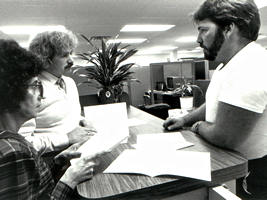 |
|
Issuing permits to
truckers has been a mainstay of Motor Carrier Services’ services to customers
for 25 years. Here, Connie Geisenhoff and Al Soder listen to a trucker
as he applies for his permit in the late-1980s. Photo by Craig Wilkins
|
When the Minnesota Legislature created Mn/DOT in 1976, the enforcement and
administrative function of the Motor Bus and Truck Division of the Public Service
Commission moved to the new agency, known today as the Office of Motor Carrier
Services.
As trucking has increased in size and scope over the decades, so too has Mn/DOT’s
responsibility for commercial trucking.
Tracing trucking regulatory roots
OMCS roots go back 75 years. State regulation of for-hire motor carriers in
Minnesota began around 1925 with the passage of the Auto Transportation Act.
Administration and enforcement of these early motor carrier rules fell to the
Railroad & Warehouse Commission.
As for-hire trucking expanded, the commission required operators to register
their trucking operations with the state. Operating authority was based on customer
need and necessity and public convenience. Carriers had to follow prescribed
routes, tariffs and schedules of rates in order to be a ‘legally operating’
motor carrier. All this regulation was meant to protect Minnesota citizens and
shippers from unscrupulous trucking operators and to maintain economic balance
in a fairly new and expanding industry.
In 1957, the Railroad & Warehouse Commission dissolved and carrier activities
were consolidated under the Public Service Commission’s Motor Bus and Truck
Division. This division supervised carrier compliance with the laws, conducted
carrier terminal visits and roadside inspection and administered carrier registrations.
A different division of the PSC (which later would become the Transportation
Regulation Board) handled approval or denial of requests for operating authority.
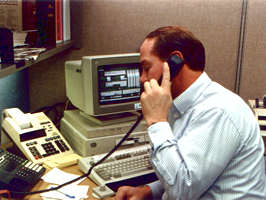 |
|
Richard Norberg provides
another valuable customer service as he helps route truckers around 1990s-decade
construction zones or spring load restrictions. Photo by Kevin Walker
|
Expanding safety enforcement activities
By 1983, Mn/DOT joined the State Patrol to participate in a new federal initiative
designed to expand safety enforcement activities, primarily for interstate carriers.
The federal Motor Carrier Safety Assistance Program provides funding to states
to help them better focus enforcement efforts on trucking operations that do
not comply with prescribed safety standards.
MCSAP also provides funding to support educational outreach that helps all
operators understand and comply with safety regulations. As a result of the
legislative auditor’s report in 1992, safety enforcement responsibilities were
better defined. The State Patrol acquired responsibility for all roadside safety
enforcement activities, such as truck inspections, weight enforcement and post-crash
inspections. Mn/DOT became responsible for audits and safety reviews of carrier
management and hazardous materials shipper safety practices.
Educating motor carriers
Educational outreach has been an important mission of the Office of Motor Carrier
Services. In 1992, OMCS began an outreach program called the Initial Motor Carrier
Program, which is a seminar providing new entrants into the trucking field the
basic information and resources they need to understand the rules and laws.
A major commitment to educational outreach came in 1996 when the Office created
a new section, Communications and Training, to consolidate its training and
informational activities.
Besides the various training classes and workshops it conducts, the OMCS training
section also publishes "Motor Carrier News," a quarterly newsletter
for the trucking industry; various technical fact sheets clarifying specific
areas of regulation; a basic truck regulation handbook, and maintains a Web
site. In 1998 the US DOT endorsed OMCS as a model for other states in how to
best provide educational and technical outreach to its motor carrier population.
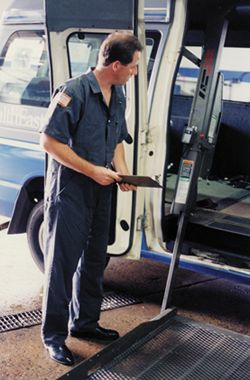 |
|
Randy Kudzia inspects
a motor van used for transporting the elderly on their errands around
town. Staff photo
|
Registering, monitoring motor carrier operations
In addition to training and education, the office registers and licenses hazardous
materials and hazardous waste transporters, conducts audit reviews of carrier
records at carrier’s place of business, maintains proof of carrier’s liability
insurance, licenses and audits the operations of special transportation services
for the elderly and disabled and of the for-hire luxury limousine business.
OMCS has hazardous materials specialists who serve on Minnesota’s Emergency
Response Team, providing support during hazardous materials incidents or spills
involving commercial motor vehicles.
Recently, certain commercial vehicle operations responsibilities have been
consolidated within OMCS. The intent is to help define and implement the strategies
the department should consider when making intelligent choices regarding future
commercial vehicle operations resource allocation and related activities.
"The trucking industry has changed dramatically over the last 25 years,"
said Ward Briggs, OMCS director. "Our office has been successful because
we have changed with the times. Right now we’re very excited about our commercial
vehicle operations initiative and the opportunities it provides to both improve
safety and streamline regulatory compliance."
For more information visit the OMCS
Web site.
By Mary Meinert
|
back

|
 |
Maintenance crews rein in widespread, troublesome storm
|
 |
 |
 |
Although storm conditions
at times forced Willmar to pull its plows off the roads, Chuck Steinbeisser,
a general repair worker at the Willmar District headquarters, shovels
from the parking lot to the door to keep a path open for employees and
visitors. Other work, such as answering calls from concerned motorists,
also went on during the season’s first snowstorm. Photo by Sandy East
|
Moist, relatively warm air carrying heavy snow stalled over Central Minnesota
Tuesday, dropping nearly 30 inches at Willmar, 20 inches at Marshall and 18
to 20 inches in the St. Cloud area, and sending Mn/DOT crews out to battle the
year’s first major snowstorm in the region.
For a while, the storm was clearly getting the better part of the struggle.
With snow falling as much as three inches an hour with high winds, the Willmar
District advised no travel and pulled its plows from the roads for several hours
in the Willmar, Marshall, Montevideo, Redwood Falls and Pipestone areas.
The Marshall area received about 20 inches, according to George Bowman, regional
maintenance supervisor at Marshall. In some areas, Bowman said, winds whipped
the heavy snow into drifts as high as eight feet. Crews have been battling the
drifts and two to three inches of compacted snow on the areas highways, he said.
Semi-trailers and other vehicles were off the roads near Lake Benton and south
of Marshall, complicating snowplowing operations. Two Mn/DOT plows, he added,
slipped off the road.
"We’re just barely getting our lanes back open and we’ve had to use our
Sno-Gos and 10-ton trucks to push the snow back," he said.
Bowman said today started with flurries, but sunshine that developed later
will help clear compacted snow from most of the region’s roads by this evening.
Crews are now gaining an edge on the snow, Bowman said.
"We have two to three inches of compaction and lanes are barely open,
but it’s softening up and we should have most roads clear by this afternoon,"
he said.
At Willmar, which received the heaviest amount of snowfall, crews also struggled
to gain a toehold on the storm.
At one point, five of the nine snowplows stationed at Willmar were in the ditch
because of the slippery conditions.
Jeff Vlaminck, regional engineer, said snowplow operators were able to begin
working after the winds subsided and made substantial progress to clear highways
in the region today.
"We’re doing pretty well now. Roads are passable and we’re using wing
plows to peel back the drifts and Sno-Gos and 10-ton trucks from Windom contractors
to blade off the compaction," he said. "It’s going to take us a few
days to get back to normal.
"It was our first storm and people worked together really well,"
Vlaminck added.
In the St. Cloud area, the storm dumped about 20 inches of snow at Cokato on
the maintenance area’s west side and as much as 18 to 20 inches near Princeton
and Mora on the east.
Randy Reznicek, St. Cloud maintenance superintendent, said glare ice conditions
also put several of his trucks in the ditch but no one suffered any injuries.
Once plowing operations began and de-icing chemicals—such as magnesium chloride—started
acting, road conditions improved throughout the region, he said.
"Our super-commuter routes such as Hwy 10 and Hwy 169 are okay and we’re
getting the compaction off the other main roads," he said.
Reznicek said the Metro Division will use its Sno-Gos to blow drifts back before
the snow freezes.
"So far, we’re doing really well," he said.
In the Twin Cities metro area, the snowfall was much lower—about 10 inches—but
the season’s first storm still resulted in stalls, spinouts and other mishaps
on the region’s highways. One Mn/DOT plow was involved in a minor collision
that did not result in injuries.
"We came out from the storm well considering it was about 10 inches,"
said Norm Ashfeld, a Metro Division maintenance superintendent. "The warm
temperatures helped."
Ashfeld said the storm provided an opportunity to test anti-icing chemicals
such as magnesium chloride and Caliber M1000, a corn-based chemical, and M2000,
a blue-colored salt with the M1000 added. The division’s forces used four trucks
equipped to use anti-icing chemicals.
"We were ready; we were much more proactive this time," Ashfeld said.
"We have more anti-icing trucks on order; I’m looking forward to getting
them."
By Craig Wilkins
|
Driver grateful for
clear roads after snow storm
This E-mail came into Mn/DOT’s Central Office Information Center
on Nov. 28 from one appreciative driver in the Twin Cities metro area.
"You 'guys' are amazing! I cannot believe how quickly you are
able to return the highways to perfect driving condition. I drive 34
miles, one way, to work and home each day. It is RARE that there is
any problem 24 hours after any storm. Today the highways (Hwy 36 west
to I-35E south to Cedar Avenue south) were clear and dry. Thanks for
making living in Minnesota more bearable."
|
|
back

|
 |
Department works together to "Shape Our Future"
|
 |
 |
The Commissioner’s Office and the Senior Management Team have determined that
resource alignment and maintaining momentum is the course of action to help
the department adapt to changing state and national priorities, the economic
climate, new technology and customer needs.
According to Deputy Commissioner Doug Weiszhaar, it is critical that Mn/DOT
be proactive in shaping its future before others do it for us.
"Through ‘Shaping Our Future,’ an umbrella plan that is guiding our short-
and long-term initiatives, we are already making Mn/DOT work better. We are
among state agency leaders in deploying both our people and our funds most efficiently,"
he said.
Information on these initiatives can be found at a new intranet location called
"Making Mn/DOT Work
Better." The site includes the latest memos, reports and presentations
about shaping Mn/DOT's future with additional information, including long-term
recommendations from the Research and Momentum Task Force. The recommendations
will be forwarded to the commissioner and SMT by Dec. 1 and presented to the
Management Leadership Team on Dec. 11.
In related news, Mn/DOT, along with other state agencies, has received a memo
from the Department of Finance directing all agencies to make recommendations
by Dec. 10 to reduce General Fund expenditures by 5 percent and to make further
recommendations for a possible 10 percent reduction in spending.
Weiszhaar said it is fortunate that Mn/DOT has already been taking a proactive
approach.
By Jeanne Aamodt
|
back

|
 |
Transportation funding ideas abound as legislative session nears
|
 |
 |
Maintaining that transportation is vital to a healthy state economy, Gov. Jesse
Ventura continues to place rail, road and bridge projects high on his priorities
for consideration during the 2002 legislative session.
Mn/DOT clearly is not alone in its push for additional transportation funding.
While health, national security and the economy remain priority concerns, mobility
and transportation issues are also in the public spotlight.
Several legislators who attended last month’s Minnesota Public Transit Conference
talked about the need to move transportation to the top of the priority list
and to find funding sources to make this happen. The following weighed in on
the state’s growing transportation needs:
-
State Senate Majority Leader Roger Moe (DFL) said the state needs to raise
the gas tax, which has not been increased for two decades and is currently
about 20 cents per gallon. "Increasing this source of funding for roads
would free up other funding for transit-related projects. The public was
ahead of the legislature in its understanding of a need for transportation
spending," Moe said.
-
Rep. Steve Sviggum (Republican), speaker of the Minnesota House of Representatives,
said that he expects the state bonding bill and a comprehensive transportation-funding
package will be the top two priorities in the 2002 session. He also expects
a "significant" bonding bill to be passed by the end of session.
-
Senate Minority Leader Dick Day (Republican) appealed for cooperation in
finding solutions to the region’s growing transportation needs. The Oct.
31 St. Paul Pioneer Press reported that although Day described himself
as "the car guy," he announced that he would seek initiatives dedicating
lottery funds and 100 percent of the motor vehicle excise tax to transportation—with
70 percent going to highways and 30 percent to public transit. "If
you’re in mass transit, get with us. We all have to get into this (a funding
solution) together," said Day.
-
The Pioneer Press also quoted Carol Lovro, Association of Minnesota
Counties. "If lawmakers approved new funding," Lovro said, "I
think the public will get up and cheer and say, ‘It’s about time.’"
Other transportation funding proposals include House Majority Leader and gubernatorial
candidate Tim Pawlenty’s announcement that he would propose using $1.5 billion
from future payments from the settlement of the state's tobacco lawsuit to make
road improvements.
By Jeanne Aamodt and Mary McFarland
|
back

|
 |
Workshop provides helpful feedback for streamlining proposals
|
 |
 |
A workshop attended by more than 100 representatives from Mn/DOT offered feedback
for streamlining in three functional areas—right of way, design and environmental
review.
The three focus areas are among seven major focus areas in the department’s
efforts to streamline the construction process.
Participants at the Nov. 20 workshop focused on proposals for getting projects
from design through completion more quickly and for less money.
Participants also included a consultant and representatives from other state
agencies. Their review will help the three streamlining task forces prepare
the final recommendations they will present to the Streamlining Steering Committee
and the Streamlining Oversight Committee in December and January.
Impetus for the streamlining effort comes from Mn/DOT’s goal to accelerate
delivery for all projects from pre-construction to completion.
"The value of the workshop stems from the task force members getting a
broad perspective about the proposals from a cross-section of Mn/DOT people,"
said Del Gerdes, director of the Streamlining Project Delivery Team. "The
workshop provided task force members with both specific input on proposals and
new ideas from the participants."
Cassandra Isaackson, a member of the streamlining team, said the session she
led on the environmental focus area received helpful feedback from staff from
Mn/DOT, the Minnesota Pollution Control Agency and the Department of Natural
Resources.
"We were able to rank our proposals, determine how much time they could
save and review their potential for implementation," she said.
The workshop also included remarks on the value and necessity of the streamlining
process by Deputy Commissioner Doug Weiszhaar, Marthand Nookala, Program Support
Group assistant director, and Jim Swanson, Program Delivery Group assistant
commissioner.
"We need to use the streamlining process to get our bigger program done,"
Swanson said. "We have $459 million from the Legislature to deliver 45
Moving Minnesota projects by 2003. For example, we need to acquire 2,500 right
of way parcels between now and July 1, 2002, when normal workload is 1,000 to
1,200 parcels per year. Streamlining will help us get projects ready on time."
Swanson said process changes such as streamlining will also enable Mn/DOT to
reduce administrative costs of projects from 17 to 20 percent to 10 or 11 percent
and to more evenly distribute project bid lettings throughout the year. Currently,
he said, bid lettings for projects are often bunched together during the months
of April, May and June.
Luncheon speaker Tom Warne, a consultant and former director of the Utah DOT
and the American Association of State Highway and Transportation Officials,
addressed streamlining from the national perspective for the workshop participants.
While serving as UDOT’s director, Warne used design-build and other streamlining
tactics to cut the time needed to rebuild I-15 in the Salt Lake City metro area
from 10 years to five years in order to have the freeway completed in time for
the 2001 Winter Olympics. Streamlining also helped bring the $1.6 billion project
in $30 million under budget.
"Customers are paramount and time is the prime commodity of the 21st century,"
he said. "People get mad if they lose five minutes. We’ve found that motorists
are more willing to suffer more pain in a shorter time rather than spread it
out in the ‘nice’ way," he said.
"People expect fast, high-quality service from the private sector, why
not expect the same from the public sector? " he asked.
Warne said transportation departments that overcome policies that inhibit creativity
and stifle initiative can respond to those demands.
Gerdes said all state DOTs are struggling with issues related to the need for
more streamlined processes.
"Project delivery continues to be a complicated process that carries a
high price," Gerdes said. "Streamlining project delivery is a challenge
that can only be addressed by working with the assistance of the whole Mn/DOT
team and with our transportation partners."
By Craig Wilkins
|
back

|
 |
New service agreements document expectations between Program Delivery, Program
Support
|
 |
 |
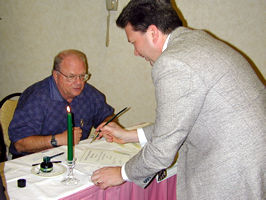 |
Mike Marttila (seated),
Construction and Contract Administration director, and Jon Husby, District
7 transportation district engineer, participate in the Program Support/
Program Delivery service level agreement signing on Nov. 13. Photo
by Tim Windorski
|
Whether the product or service is a car repair, an appliance warranty, or a
contract for cable television or Internet access, businesses and consumers alike
rely upon service agreements to clarify what buyers and sellers expect from
each other in specific transactions.
This tool—service agreements—has now come to Mn/DOT to play a similar role.
On Nov. 13, office directors and district engineers formally signed a series
of service level agreements that—among other goals—outline what Mn/DOT’s Program
Support offices and Mn/DOT’s Program Delivery Group (Metro Division and Districts
1 through 8) will expect from each other for the fiscal year 2002-2003.
"This is a reason to celebrate. Service agreements are important because
everyone will understand what’s expected from them, and we will understand what
services we are expecting from others," Deputy Commissioner Doug Weiszhaar
told signers.
Mn/DOT developed service agreements as part of the new business planning process.
This process now directly ties everything identified in the business plan to
agreements for needed services such as investment proposals, performance measures
and outcomes.
"What we’re doing with service agreements is documenting where we’re at
right now and putting together whatever fits best in the right places to move
Minnesota," said Jim Swanson, assistant commissioner, Program Delivery
Group. "This is a joint effort between Program Support and the districts
to see how we can make this all work."
Besides documenting who provides what services, the agreements can also help
with:
-
Surveying satisfaction of internal customers;
-
Comparing costs among offices and districts;
-
Defining products and services for each office and district; and
-
Identifying areas that may need streamlining.
Service agreements are also part of both the resource and momentum initiative
and streamlining efforts to realign and match Mn/DOT’s resources to identify
needs such as Moving Minnesota.
"By outlining the roles and responsibilities of everyone," explained
Pat Hughes, assistant commissioner, Program Support Group, "it helps put
accountability in the right place to deliver what our customers expect."
Mn/DOT first began using service agreements in January 2001 as a pilot project
tested by the offices of Maintenance and Human Resources and District 1. Since
then, all 14 Program Support Group offices have developed agreements with Metro
Division and each district. Planning has already begun for the next round of
service agreements needed for the 2004-2005 business planning cycle.
|
back

|
 |
Hearing, speech assistance equipment installed in new Albert Lea rest area
|
 |
 |
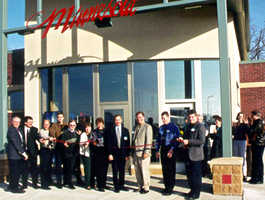 |
The Nov. 16 event at
the I-35E rest area near Albert Lea featured a "ribbon-joining"
ceremony, staged to emphasize successful partnership that helped make
the rest area, travel information center and TTY equipment a reality.
Photo by Brian Jergenson
|
Travelers on I-35 in southern Minnesota who have
hearing and speech disabilities can now make telephone calls from a new safety
rest area near Albert Lea—thanks to the TTY equipment (teletypewriters for hearing
impaired people) Mn/DOT has installed on pay telephones at that location.
"The goal is to make rest areas accessible for all citizens who need
to use the telephones for convenience or in emergency situations," said
Commissioner Elwyn Tinklenberg.
The I-35 Albert Lea rest area reopened earlier this year with a new building,
expanded parking, a new water treatment pond, and new walking trails. The site
is a full service facility that serves as the gateway to Minnesota from areas
to the south. Approximately 600,000 travelers visit the Albert Lea rest area
each year.
TTY equipment has been installed at ten safety rest areas located throughout
the state this year. The St. Croix Travel Information Center and safety rest
area on I-90 has had TTY equipment installed for several years.
"Mn/DOT is in the process of finalizing plans for a new statewide public
pay phone contract that will include installation and maintenance of TTY equipment
at all 55 full-service rest areas with pay phones," said Carol Reamer,
Mn/DOT safety rest area program manager.
Mn/DOT is working with the Deaf and Hard of Hearing Services Division’s eight
regional service centers to explore the best highway and on-site signage and
public notification opportunities to inform the traveling public of these new
services.
By Brian Jergenson
|
back

|
 |
Seeds students learn about career resources at development day
|
 |
 |
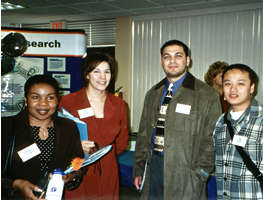 |
As part of Seeds Career
Development day, Seeds students mingle and learn about the different districts
at the Graduate Engineer Program Grad Expo on Nov. 16. From left are Dorothee
Muue, Tracy Ravenscraft, Diaa Abu-Shaqra, Tho Nguyen. Photo by Maya
Beecham
|
Two dozen Seeds student workers statewide attended a half-day career development
event at the Arden Hills Training Center on Nov. 16. The Seeds office, in conjunction
with the Seeds Development Subcommittee for Special Events and Program Planning,
sponsored the program to promote planning for possible careers within Mn/DOT
and the State of Minnesota.
Seeds is a statewide program that offers minority or economically disadvantaged
students the chance to grow through on-the-job experience and prepare them for
possible full-time, permanent employment at Mn/DOT. Students in the Seeds program
represent a wide range of disciplines including information technology, communications,
law, landscape architecture, clerical and civil technicians.
Sandi Satovich from the Department of Employee Relations taught students how
to navigate through the DOER Web site to learn about job categories and classifications,
how to check job postings, where to download an application and how to build
a resume.
Ron Bisek, training and development, and Emma Corrie, Seeds program manager,
introduced students to Career
Explorer, a personal assessment tool on Mn/DOT’s intranet site. This site
helps individuals make decisions, set goals and take responsibility for enhancing
future career satisfaction within Mn/DOT. Students were encouraged to work on
some of the worksheets and attend follow-up sessions as needed.
Seeds students were also given the opportunity to participate in the Graduate
Engineer Program Grad Expo. Districts and offices set up booths to talk to students
about Mn/DOT and about opportunities available in their areas.
For more information about the Seeds program or to hire a Seeds worker, contact
Emma Corrie at 651/297-3897.
By Shayla Cain
|
back

|
 |
New on the Web: News from the Commissioner's office
|
 |
 |
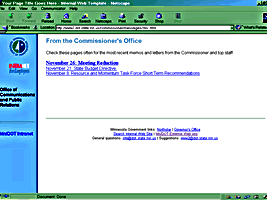 |
To help improve the
flow of communication, the Office of Communications and Public Relations
will begin posting memos from the Commissioner and staff on the Mn/DOT
intranet.
|
With the flurry of activity around new initiatives, potential budget cuts and
the upcoming legislative session, the memos have been flying out of the Commissioner's
Office.
These memos are generally sent to managers with instructions to pass the information
along to employees, but the trickle down process can take time and important
messages can get lost in the shuffle.
To help improve the flow of communication, the Office of Communications and
Public Relations will begin posting memos from the Commissioner and staff on
the Mn/DOT intranet. Check out the site at: http://www2.dot.state.mn.us/commissioner/messages2002.html
By Kay Korsgaard
|
back

|
|
 |
|



